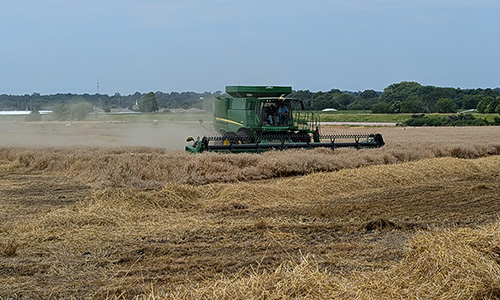NORFOLK, Neb. – Northeast Nebraska, especially around Madison County, isn’t known for its wheat production.
So, it might have been a little surprising when some people driving near the Northeast campus this spring and summer noticed two wheatfields. And given the yield and other factors that the experiment provided, it’s a safe bet it will be tried again.
Jason Hansen, associate director of the Northeast college farm, said 31 acres of hard red winter wheat were planted last September.
Hansen said he personally had planted winter wheat, but in looking through college records, he couldn’t find any evidence that it had been planted on the college farm.
“You can plant it after you cut silage or after you combine beans,” Hansen said. “That’s typically the type of crops it follows.”
Both wheat fields were harvested last week, averaging 80 bushels an acre. There were spots that averaged 120 to 130 bushels, with a few spots that dragged it down. For dryland wheat, the yield was outstanding.
‘Perfect Storm’
With winter wheat, it is ideal if it can get about two to three inches of growth before the first frost. At that height, it can withstand the winter.
“Last year, the conditions were ideal,” Hansen said. “We had a lot of fall rain, so it got started well. And the big snow we got in December, that was a huge benefit to that crop. It provided a lot of nitrogen that pushed down on the plant, and it absorbed it all. It was the perfect storm. I don’t know if we will be able to duplicate that again.”
Dryland wheat in southern Nebraska and Kansas doesn’t get as much precipitation, and usually averages about 40 to 60 bushels an acre. In fact, with 80-bushel yields, wheat could find itself in a mix with the corn and soybean rotation around this area for profitability.
Since there isn’t much wheat grown here, the college checked with FSA (Farm Service Agency) and discovered that the historical average of wheat in Madison County is 45 bushels an acre.
And there are other benefits to growing wheat. It is a rotational crop, and planting winter wheat every three years helps to break up the bug and weed cycle and improve the health of soil.
And unlike corn and some row crops, there isn’t a lot of work that must be done with it once it is in the ground.
The straw left after harvest is beneficial as well. It produced about 1 ½ tons per acre, with about 150 square bales produced for livestock bedding and the rest turned into round bales.
‘Try it Again’
“We’ll try it again. We’ll put some winter wheat in again this fall behind some silage or possibly behind a soybean field. I haven’t decided exactly where yet.”
Colleges play an important role in research for crops, including opportunities for students to learn and conduct their own investigations.
Probably the biggest determinant to growing wheat in this region is there aren’t a lot of markets for it locally. The harvested wheat was sold to Scoular Grain in Fremont.
Wheat is typically ground into flour and used in breads, cakes, cereal and more.
Winter Wheat Harvested
Hard red winter wheat, which was planted last September in two fields on the Northeast Community College farm, was harvested last week. The experiment was so successful with a high yield that it will be planted again this fall. (Northeast Community College)
###

